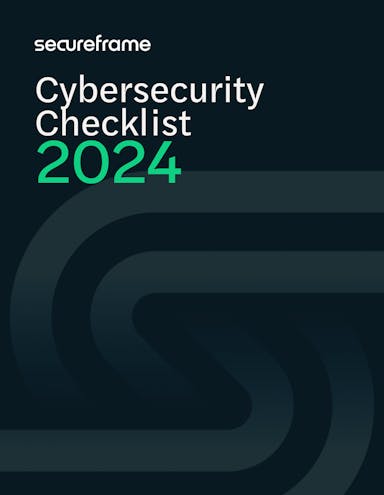
4 Ways Cybersecurity Leaders Can Prepare for 2024
Emily Bonnie
Senior Content Marketing Manager
Anna Fitzgerald
Senior Content Marketing Manager
Annual global cybercrime costs are predicted to hit $9.5 trillion in 2024 — that’s $26 billion every single day.
These rising costs are due to constant shifts in the information security landscape, forcing organizations to focus time and resources to keep pace. New and refactored threats are emerging and bad actors are always exploring new ways to infiltrate organizations and systems, putting cybersecurity leaders and their organizations on constant defense.
Generative AI and social engineering are leading to more sophisticated and convincing attacks. Organizations are managing a growing amount of third-party risk, on top of an increasingly complex regulatory and compliance landscape. In addition, a severe talent shortage is leaving millions of information security roles unfilled and existing teams stretched thin.
The best information security professionals are proactive in anticipating change and preparing their organizations for emerging threats. Below, we outline top priorities for cybersecurity leaders to guard against the challenges ahead in 2024 and beyond.

1. Develop an adaptive risk management approach
Today’s organizations are in a constant state of flux. New cyber threats, attack methods, and malicious actors are emerging almost daily. Modern IT environments are complex and dynamic, with the adoption of cloud services, IoT, mobile devices, and remote work. Compliance and regulatory requirements are similarly evolving, and business objectives and growth strategies change to meet market demands. By taking an adaptive approach to risk management, cybersecurity leaders can be flexible and responsive to these changing conditions and business needs.
This adaptive approach requires cybersecurity leaders to conduct continuous risk assessments and regularly engage with stakeholders across the organization to ensure that cybersecurity strategies stay aligned with business objectives. Incident response plans must also be regularly reviewed, updated, communicated, and practiced to ensure quick and effective action in the event of a security breach.
CISOs and cybersecurity executives must also implement flexible and scalable security controls, including emerging technologies like artificial intelligence. Machine learning algorithms can sift through massive data sets to identify patterns and anomalies and flag potential security threats. In the event of a security incident, those same AI systems can identify the source of the leak, contain it, and minimize damage by blocking malicious IP addresses, shutting down compromised systems and user accounts, and flagging potential phishing attempts.
Cybersecurity leaders must have a thorough understanding of risk impact so ensure their security operations centers are focused on the right things at the right time. But they also have to be smart about how they treat those risks so their strategy is proactive, adaptive, and (when appropriate) reactive. By implementing an adaptive approach, organizations can evaluate and analyze behaviors and events in real-time and take meaningful preventive actions before a breach.
Recommended reading

How Artificial Intelligence Is Shaping the Future of Cybersecurity
2. Pair cybersecurity with cyber resilience
Preventive measures will always be critical, but 2024 will see a stronger emphasis on cyber resilience, which refers to an organization’s ability to withstand, recover from, and adapt to security incidents and attacks. Even the strongest security practices can’t eliminate all risk, and no functioning system is 100% secure. Cybersecurity leaders are placing a greater strategic emphasis on incident response and recovery. How can organizations build an airtight business continuity plan? What steps can they take to minimize data loss, downtime, and other disruptions in the event of an incident?
A major factor in successfully building cyber resilience is a shift away from “checkbox security.” Too many overworked security and compliance teams are asked to do X, so they check off X.
To build cyber resilience, the best security leaders stop to ask: Why is X important and is it solving any real problem? Is X actually impacting security or privacy risks in a material way? Checkbox security is dangerous because it gives the appearance of security without mitigating the underlying risks or problems that exist in the business. Cybersecurity leaders have to refactor those checkboxes into more dynamic tactics that support an evolving business strategy and environment — and the shift is already in motion. According to a recent survey, 70% of corporate risk and compliance professionals say they have noticed a shift from check-the-box compliance to a more strategic approach.

3. Increase visibility across the organization
Visibility not only builds trust among stakeholders and customers, it ensures decision-makers are well-informed about cybersecurity risks and the effectiveness of current security measures and initiatives. Leaders and employees alike have a better understanding of what’s being done to protect information assets and can make more informed decisions at all levels of the organization.
For success in 2024, organizations must prioritize regular, open communication and inter-departmental collaboration. Leaders must be intentional about building feedback mechanisms where personnel can report potential security issues, and where that feedback is put into practice to improve security practices. For security teams, this enables a unified approach to cybersecurity and data protection and a more complete understanding of needs across the organization. And for other stakeholders, it allows for more meaningful discussions around risk tolerance, identification, prioritization, and mitigation tactics.
Regular reporting and shared dashboards can increase the visibility of security operations and offer insights into day-to-day operations, demystifying what the security team does and how it contributes to the organization. Collaborative risk assessments, cross-departmental cybersecurity committees, and joint training exercises can also showcase the value of the security operation center’s efforts to other departments while fostering a more unified approach to cybersecurity.
This increased visibility opens the door for cybersecurity to be an essential part of broader strategy decisions, illustrating its role in both enabling and protecting business operations.
4. Focus team resources for maximum impact
The security, privacy, and compliance industry is facing a massive talent shortage — nearly 3.4 milion open positions remain unfilled. Almost 70% of cybersecurity professionals feel that their teams don’t have enough staff to be effective, and more than half of employees at organizations with workforce shortages view their organization as being at moderate or extreme risk of a cyberattack.
With limited in-house expertise and difficulty finding talent, organizations must find a way to focus their security team’s expertise on meaningful and impactful problems. Yet more than half (53%) of security professionals say the most frustrating aspect of their work is time spent on manual tasks.
If your security and compliance professionals are mired in mundane tasks, they’re not contributing to your organization at the level they could be, leading to wasted time, resources, and revenue. It can also lead to burnout and turnover of those precious resources.
In many cases, these time-consuming and error-prone security and compliance tasks can be automated, including data and evidence collection, communication and reporting, and cross-departmental workflows. Through automated tools, organizations can effectively increase the productivity and impact of existing employees without having to invest in new hires.
Automation allows companies to more easily and quickly address routine security tasks and compliance requirements by:
- Continuously monitoring systems
- Automatically collecting documentation and evidence for routine audits
- Automating responses to RFPs and security questionnaires with AI
- Streamlining employee onboarding and offboarding, and security training
With so many tedious, repetitive compliance tasks resolved, security leaders can free their teams to be more strategic about how they contribute to the business, protecting the organization's most valuable assets and ensuring business continuity.

Cybersecurity checklist for 2024
Regularly evaluating security controls and practices can help you take a proactive approach and ensure your organization is prepared for challenges in 2024 and beyond. Use this downloadable security checklist to assess your current security practices, close any gaps, and fortify against future threats.
Staying ahead of the challenges
The role of the CISO and cybersecurity leader is increasingly exacting. They must be aware of the technology, process, and people-related challenges facing their organizations, and they must find ways to solve those challenges while meeting business needs. It’s a tricky balancing act — one that requires them to take a proactive approach to fortifying their organization’s security and privacy posture.
To stay ahead of these emerging challenges, CISOs must empower their teams and take a rigorous yet flexible approach to risk management. By embracing new security, privacy, and compliance technologies, teams can apply their full knowledge and expertise to these emerging, complex issues and move beyond a checkbox approach.
Learn how Secureframe can empower your security professionals to automate and streamline routine tasks and focus on higher business priorities. Request a demo with a product expert today.
Use trust to accelerate growth

Emily Bonnie
Senior Content Marketing Manager
Emily Bonnie is a seasoned digital marketing strategist with over ten years of experience creating content that attracts, engages, and converts for leading SaaS companies. At Secureframe, she helps demystify complex governance, risk, and compliance (GRC) topics, turning technical frameworks and regulations into accessible, actionable guidance. Her work aims to empower organizations of all sizes to strengthen their security posture, streamline compliance, and build lasting trust with customers.

Anna Fitzgerald
Senior Content Marketing Manager
Anna Fitzgerald is a digital and product marketing professional with nearly a decade of experience delivering high-quality content across highly regulated and technical industries, including healthcare, web development, and cybersecurity compliance. At Secureframe, she specializes in translating complex regulatory frameworks—such as CMMC, FedRAMP, NIST, and SOC 2—into practical resources that help organizations of all sizes and maturity levels meet evolving compliance requirements and improve their overall risk management strategy.